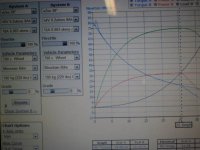chvidgov.bc.ca said:
Thanks all. Sounds like I need more controller voltage-wise, and maybe some thicker wires on the motor itself. Not looking for torque here, just decent assist in the low to mid 20s mph range with an ultralight freewheeling motor. I'll put the KU63 on the shelf and use the chopped KU123 - I've used that a lot at 48V Ping xon a BPM - Its a good controller. Just need to limit the amps a lot. Luckily these units are cheap. This is a rather different build than I'm used to, focussing on "less is more" - maybe.
Sounds like I need more controller voltage-wise
No, you are not getting what I'm saying. Look at this sim. on Ebike CA;

12S(46V) X 18A = 620 Watts = 25.7 mph(no load speed)
14S(54V) X 15A = 620 Watts = 25.7 mph(no load speed)
Est.-16S(62V) X 10A = 620 Watts = 25.7 mph(no load speed)-This will come at the loss of all low RPM power
Not looking for torque here,
Wrong again. Your top speed is set if you do not want to exceed the sustaiable power limits of the Q100(more on this in a moment).
This motor wheel configuration is POWER limited, NOT rpm limited! Increasing Voltage above 15S is pointless, as you do not need to turn it faster.
Increasing the current will increase the wheel/motor rotational force. Although that does not show up in this sim. it is there and in the real world, you will want as much of this as possible.
So what are the limits of the Q100?
The max. Watts it can sustain is debatable(I'm not willing to go there).
But what is NOT debatable is this;
Below and and at 600 Watt constant, the Q100 is quiet, smooth and happy.
Above this 600 Watt threshold, it becomes increasingly louder, a combo of a whine and a growl.
Above 700 Watts, it fairly well screams that it is not happy. It can be run this way, very carefully, by not maintaining that value for long.
Do you want a quiet assist motor or a screachy one?
and maybe some thicker wires on the motor itself
Good luck on this one. There just isn't room to maneuver in there and it's doubtful it would make any difference. It's just a tiny motor, it is what it is and up-grading the wires isn't going to change that.
A note on the sim.'s no-load speeds.
Generaly, my experience with the sim., is that it's top speed numbers is dead on(a testiment to Justin's genius). But that is cases where the no-load comes about as a function of motor rpm. It cases where the NLS is a function of total power out-put, the number appears to be slewed upward. Unless I miss my guess(based on my Q100 328 in a 24"wheel @ 12 and 13S), that number would need to be reduced by 10%.
Back to the sim.-So what are the advantages of 12S vs. 14S.
Although not showing on the sim., 12S on 18A would have a little more pull off the line and up hills and help battle headwinds. Headwind are going to have a major impact with your proposed motor/wheel combo. Even a few extra mph will have you pedaling in ernest to maintain speeds above 20 mph. Same with inclines, it won't take much to start slowing you below your desired cruise speed.
The 14S/15A combo would allow you to pedal and contribute above the NLS(note the flat-line).
A maxium oft stated here on E.S., is; Gear down, up the Voltage.
But since your proposed motive force is already geared(by way of the wind and wheel size) very high, your mantra should be;Geared high, Volts down[up current].
P.S. Twin fast wind Q100's on your bike, running @12S/(2)16A shows a top speed of 30mph[say, real world, 27 to 28 mph)and climb most any hill.


